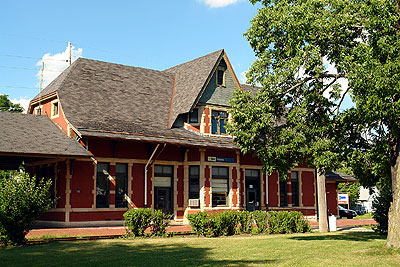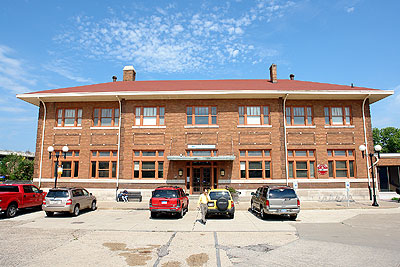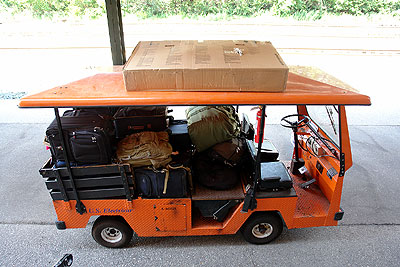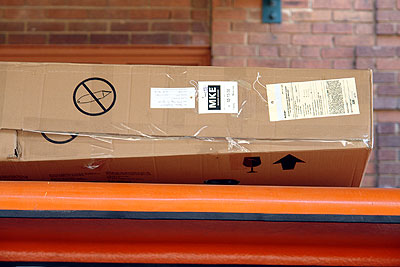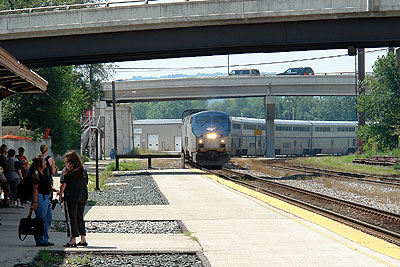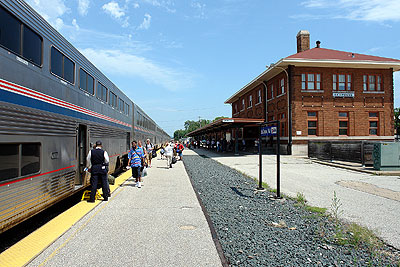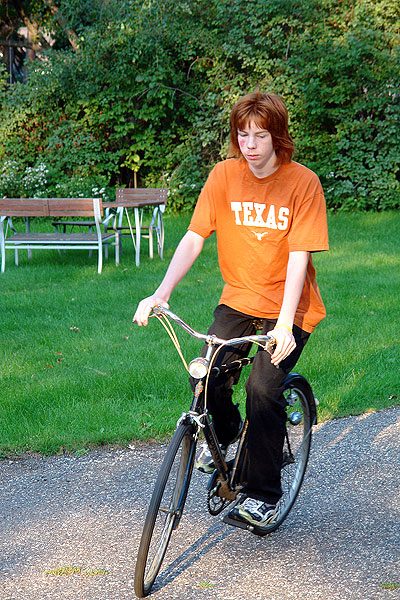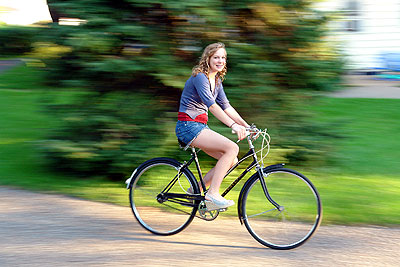Others have felt this as well, have served on the BAB for a time then left in frustration or disgust to work other avenues. On the other hand, some things have got done. There are bike lanes painted on Como Ave. now, Share The Road signs have sprung up, there have been a couple of public meetings to solicit bicycle input and the recent heads of the BAB worked up the Bicycle portion of the Saint Paul Transportation plan. Perhaps it's the speed that things move that seems so slow, it's like walking off the end of one of those airport moving sidewalks where you suddenly slow down, like the Star Wars leap to light speed in reverse. You ask for something simple like a resurfacing of an existing bike path that is in bad enough shape that cyclists are returning to the adjacent highway and are met with all the problems, Scenic River Committee plans, DNR involvement, path not up to current design standards, DOT study of additional access points to road and how that will affect the path, some on county land, blah blah blah. All we really want is a six foot-wide path resurfaced, it'll be another 40% more expensive next year, but there's this flak cloud of objections. Perhaps someone sympathetic will get killed and that'll hasten things along, in the meantime the BAB seems like a long and tedious slog in a policital milieu in which I'm not used to operating.
Bike lanes or no bike lanes, I think more people are going to be riding in any case, led along by higher fuel costs and the rising popularity of city bikes, which have been big at last week's Interbike (Quality Bicycle Products just introduced their Civia line which, from the photos currently on the site, apparently include a generator hub but no lights, and I've long been a fan of the Breezer Uptown 8 where they had the guts to spec the Nexus Redband 8-speed Premium hub instead of the heavier Nexus 8 and do include lights along with the generator hub). If it's going to take until 2014 for the studies to be complete before we can commence the planning for the design criteria prior to the RFP to repave this stinking bicycle path then there must be something I can do in the meantime.
So I looked into the League of American Bicyclists League Certified Instructor (LCI) program. There are currently just three active LCIs in Minnesota and the profile of the LAB is so low you could slip it under the door. Not only that, it seems to have been through some turmoil. From what I gather, the LCI program arose from the Effective Cycling work of John Forrester. He's an opinionated guy and holds that cyclists fare best when they act and are treated as drivers of vehicles. Broadly speaking, I agree with this, but in the ways of so many cranky cyclists and the Roman Catholic Church, broadly agreeing isn't quite good enough, and there was some schism in the LAB. I haven't bothered to discern all the fault lines here, but there is a whole website called LAB Reform which goes on about Board actions, copies emails and quotes bylaws. I've been active in churches and charter schools in the past and recognize precisely the sort of self-righteous outrage in this site. When people start quoting bylaws then things have really fallen apart. (Not only have I seen this in churches and schools, but the bicycle-oriented Thunderhead Alliance just chopped their executive director as well, undoubtedly after the requisite internal bitterness) (but not before she got top credit on their new 2007 Benchmarking Report "Bicycling and Walking in the U.S." which I printed out but haven't had time to study yet). The League is apparently trying to restore rigour to the LCI program after a period of what some felt was too simple a qualification (this is hearsay, I don't personally know how the program changed).
The Iowa Bicycle Coalition led by Mark Wyatt wanted to increase bicycle education in Iowa and decided to train some LCIs. This meant having candidates do the Road 1 course, the basic LAB cycling course for adults, and then subsequently do the LCI training which is basically learning how to teach Road 1 and a couple of other classes for Commuters and Kids. I follow the IBC site and noticed the announcement of these classes so pestered Mark long enough and cited my Iowa connections enough that he let me in. Road 1 was in late August. The LCI course was September 21/22/23.
This was actually pretty good. The League's been around since 1880 (as the League of American Wheelmen with a really cool LAW logo rather than the gender-neutral League of American Bicyclists with LAB which sounds like a dopey dog). The LCI course has evolved out of the course they actually called Effective Cycling, which is now a registered trademark of John Forrester.
Some of the materials need updating:

Before riding, perform the ABC Quick Check. Here our rider sights down the chain line. Yep, looks good!
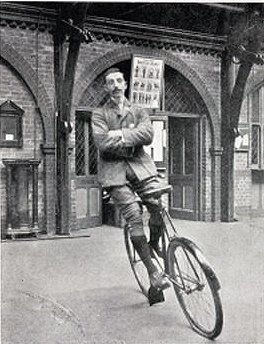
A fundamental skill is to be able to check traffic behind you while riding in a straight line. This also helps communicate with motorists. What do you think this rider is communicating?
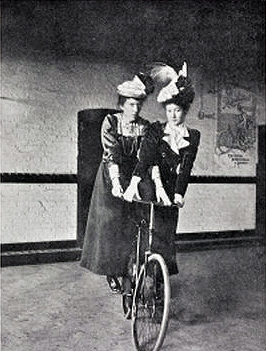
Keep a firm grip on the handlebars! Yes, there were some women in the course as well.
[OK, OK, these aren't actually LAB materials. They're from the 1901 Fancy Cycling: Trick Riding for Amateurs by Isabel Marks. And you thought spinning the front wheel on your fixie was cool!]
They have been updating some of it and we were on the cutting edge. When we took the Road 1 course in August (14 or 15 of us versus the 11 in the LCI course) we were shown the old LAB movie. This was from probably 1988 or so and featured a smarmy actor I've never heard of ("Joe Blow, Hollywood star") and such a procession of old bicycles, cars and helmets that it was hard to pay attention to the message (Hey, look, a Pinto!) (I had one of those helmets!) (Jesus, remember those shoes?). The new movie instead has an actress presumably taking an older male friend on a bike ride. This poor actress is stuck with the thankless task of droning out all the Important Points in a way that no real humans ever speak to each other ("But Bob, you should wear a helmet whenever you ride and it should be level on your head with the straps properly positioned and snug around your chin" instead of what we'd really say, something like "Hey idiot, where's your helmet?"). This guy rides so little he has to clear a levee of flotsam out of the way to get his bike out but she wreaks her revenge by apparently taking him on some 80-mile multi-hour ride, whining all the way ("But Bob, you should signal your right turn by holding your left arm out bent up 90 degrees at the elbow although in some states it is now legal to signal by pointing right with the right arm so you should check your state laws and local ordinances"). Oh the whole, the new movie is a lot better than the old one but after a while I'd want to extend my left arm out, knock her over and make a run for it.
The LCI training ran 3-8 on Friday, 8-9 on Saturday (and I don't mean 1 hour) and 8-6 on Sunday. Some of it was classroom work, discussing learning styles and how to address them, various exercises. Much of Saturday morning was each of us doing a 10-minute presentation on an assigned topic. My buddy Paul from Cedar Rapids (who had independently arrived at the idea of doing this class) got the thankless task of explaining gearing and derailleur adjustments but my Atlantis saved the day due to the wondrous SKS/ESGE/Pletscher two-legged kickstand which, due to some quirk of geometry on that bike, clears the crank arms completely. Paul put the bike up on the table and demonstrated this stuff right in front of us, the huge bike towering over the class as he showed the derailleurs shifting and adjusted my cables out of whack ("This is what it sounds like when the derailleur is badly adjusted" he'd say, twiddling away at my barrel adjuster). Others had to do their units on lane positioning, safety statistics, brake adjustment and operation, helmet fit and changing a flat tire. Mine was clothing and accessories, which was funny because I hadn't really packed thoughtfully ahead of time so brought most everything cycling-related at the last minute. I showed off my Bell Metro helmet with its mirror, gloves, the always-impressive Rainlegs Assless Bike Chaps, SPD shoes, legendary Jong Won JSB-500 water bottle, Carradice Nelson Longflap with Nitto Quick Release, panniers, Ortlieb front bag, wool jerseys, etc. My presentation was a modest hit.
That afternoon we went out to work out the outdoor parking lot units. There are some basic skills the LAB teaches; a Quick Turn (especially useful when someone tries to Right Hook you and you use it to turn inside them, and taught as countersteering in the Motorcycle Safety Foundation classes), the Panic Stop (emphasizing the front brake and shifting your weight backwards to keep from going over the bars and helping the rear wheel to maintain traction) and the Rock Dodge (that quick wheel twitch you do to miss a rock without actually changing the overall direction of the bike). To experienced cyclists, these seem pretty straightforward, but to a lot of people, it's new ground. The Road 1 course has you set up these obstacles in a parking lot using tennis balls cut in two and running people through them. Here are some of the parking lot scenes from Saturday afternoon and Sunday morning.
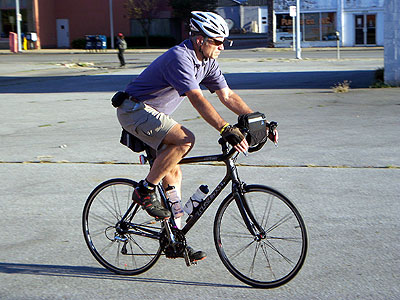
Carl returns to the start of one of the exercises. It was getting late and we actually managed to talk a pizza shop into delivering $80 worth of pizza to a parking lot at the corner of Third and Locust.
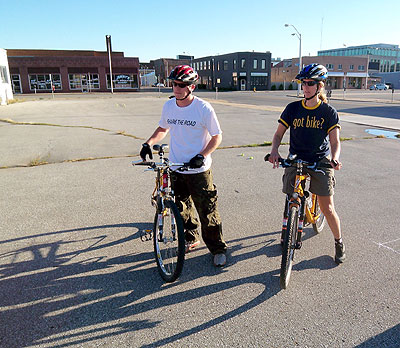
Zac's a Transportation Planner, Angela is an ex-state-trooper, Legislative Ombudsman and Des Moines's Bike to Work Program Director.
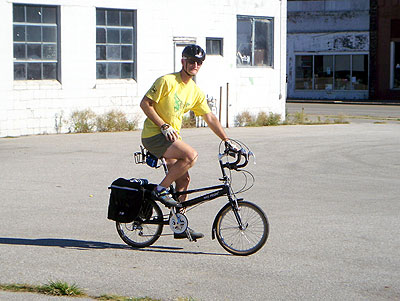
These folding bikes can look a bit daft but Paul rode his 140 miles over from Cedar Rapids.

Sunday morning we did the parking lot exercises for the Kids classes. Here Donnie and Zac compete in the always-popular slow race. You don't do this in Road 1.
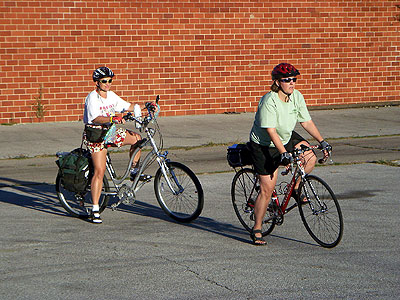
Lori and Tina line up for the Quick Turn exercise. Tina didn't learn to ride a bicycle until she was 30.

Dan Ring doing well slow-riding on his Bike Friday. Iowa Bicycle Coaltion head Mark Wyatt is in the background.

The long time frames in the Saint Paul BAB look horrendous when viewed at the start, but we left Des Moines in 1994 to take a job in Minneapolis and they were talking then about the renovation of the East Side of downtown to be done in the unimaginably distant 2008 or something, and, well, here we are, the East Village (as they call it) is hopping, they have way more bicycle parking than, say, the Saint Paul Farmers Market (a shining symbol of the BAB's power!) and publicly-provided dog poop bags! No shit!
We'd each do our presentation, whether inside or out in the parking lot, then John Rider, the instructor, would ask us what we thought went well and what didn't, and the other LCI students would critique the presentation. We were getting to know each other pretty well; several of the Iowans already know each other, and we'd all done Road 1 in a day in August and were now in the midst of three days of the LCI class. This exercise was actually pretty useful, and made us think about and rapidly improve the way we talked, where we stood, the instructions we gave. It was particularly fun Sunday morning when we were instructed to act like 7th graders and responded with a welter of "Donnie farted!" and bicycle insults. Wait--bicycle insults sounds like 30-year-olds.
The last thing Saturday night was the night gear test, where we all rode to a dark path by the river and rode up and down the trail one at a time both with and without headlights shining on us to see how our reflectors and lights looked. This was illuminating har har. Sunday afternoon we did the road test, where in two groups we went out and did a 7 mile ride, alternately leading the group through a variety of traffic obstacles. It was surprisingly hot and very windy out.
There was a debriefing with John. Carl went first; he lived closest by, but a friend's 23-year-old daughter had been killed in a car crash and visitation was at six. Paul and I went next, as we were driving the furthest (Paul came to Saint Paul overnight, then took his Bike Friday on Amtrak the next morning to Washington DC and Cape Cod to visit a couple of his sisters). I noted to John that the League and the LCI program seemed a bit in transition and that they should get their act together. I pointed out a number of nagging errors in the text and a couple of stupid and even hilarious typos. Fundamentally, the set program of instruction, the base skills, the overall message was really good, but it is quickly undermined by mistakes or inconsistencies in the materials. If you're going to hold yourself out as the authority on bicycle education, the materials have to be excellent and error-free and the message consistent. It looks like the League is working on this; the parking lot drills instruction handout was very well done and new within the past month, and the video of the woman whining at Bob was much better than the old "hey look at that" one from the 1980s. Paul did his debrief as well, and we headed back to Saint Paul, pulling in right at eleven.
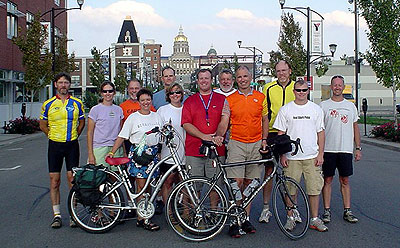
The traditional class shot, by some passer-by on Mark Wyatt's camera. Left to right you can see John Rider, League of American Bicyclists Regional Trainer (from Madison) and our teacher; Angela Dalton, Des Moines Bike to Work Program Director; Daniel Ring from Muscatine who I don't think has any official capacity but who I believe has commuted since the 1960s; Lori Leporte, Past President of the Des Moines Cycle Club and on the Board of Directors of the Iowa Bicycle Coalition; my old chum Paul Salamon from Cedar Rapids, who has no official cycling capacity but has ridden for ages; Tina Mowbry of Altoona; Mark Wyatt of the Iowa Bicycle Coaltion, who organized this training and who I believe also runs the Iowa Bike Summit (next one in January 2008); Mike, a consulting engineer from Des Moines; Carl Voss, who among other things serves on the Des Moines Trails and Greenways (TAG) Advisory Committee; me, of the famous Saint Paul Bicycle Advisory Board (which has basically no web presence); Zac Bitting, Transportation Planner for the Des Moines Area Metropolitan Planning Organization; and Donnie Miller, who owns Donnie's Indoor Cycling Experience in Moline, Illinois, is the Safety and Education Director for the Quad Cities Bicycle Club and is the Coach and Vice President for the Double "I" Cycling Experience Racing Team. Part of the fun of the weekend was all the riding styles; Donnie was very much the racer, Zac a mountain biker and a couple of these folks are big recumbent riders but went conventional for this course.
So once the paperwork clears, we'll all be LCIs, and eligible to buy the cool Instructor jerseys. I'll be the fourth active one in Minnesota though I have no doubt there have been others over the years who have drifted away or lost interest or gotten pissed at or disgusted with the LAB or one thing or another. I'm not sure if it's a widespread phenomenon, but two of the participants mentioned that there were local LCIs in their areas already but that they were such unpleasant old coots that people didn't like to use them any more. Perhaps it's healthy to have some new LCIs coming in who are agnostic on the old battles. I think there is some prestige among LCIs in having low numbers and mine of course will be unfashionably lofty (though, I'm hoping due to last-name order that it'll be lower than my buddy Paul's!) but in at least a couple of cases it sounds like a bit of fresh and friendly blood is just what's needed. I'm not entirely sure what I'm going to do with my LCI; contact the other ones to start with, I guess, to see see if they have any Road 1 plans. I do see a lot of need for training. In fact, I came up with a slogan:
They say you never forget how to ride a bicycle.
Actually, a lot of people never really learn.
Suddenly more sensitized to it, I see idiocy and incompetence all around. Yesterday, Saturday, I was at a ribbon cutting for the Lilydale Regional Trail extension, it was Saint Paul Mayor Chris Coleman and U.S. Representative Betty McCollum and speeches and thanks all around and a green ribbon and a huge pair of scissors, the culmination of some political, planning and funding process that stretched back God only knows how far, and while we're there some guy rides up and asks to get through and he has his helmet on backwards. Then last night, coming home from a chamber concert at church just after 10, a cyclist cuts left from the right hand side of the road across the cars starting off as the light turns green and across the intersection and off to the left. One of the cars honks at him, as well it should, it was an idiotic move, and the cyclist flips him off as he rides lightless down Lyndale. I didn't correct the helmet doofus (he looked like maybe he meant it and would regale you with 10 minutes of theory why, or that he wouldn't take kindly to having such a public error pointed out) or chase down the lightless idiot left-turner, I could puff up my chest all I want and say I'm an LCI, but that and $3.31 will get you a latte at Caribou. I also doubt that either backwards helmet-man or lightless flipper offer would take a Road 1 course, but perhaps there are people out there who would like to learn how to operate in traffic and to whom we can transfer the knowledge and training needed to give it a try and get out there. In the end, the best argument we have for bike lanes, bike bridges and bike parking will be more bicycles, and, as I said waaaay back at the beginning, maybe this LCI thing will be a channel to work on the training part while in the BAB I nudge and wheedle on the facilities bits.
[Want to join the LAB? Besides this education stuff, they also lobby on behalf of bicyclists in Washington DC. If you join using this link I get credit for it! In what is sure to be a popular move among Local Bike Shops, every person who joins gets me a discount coupon for Performance; every three get me a chance to win a bicycle in a raffle. These prizes don't mean much to me; I've never ordered from Performance and the bicycle is undoubtedly not made in my size, but having a voice in Washington can't hurt. Give it some thought.]
